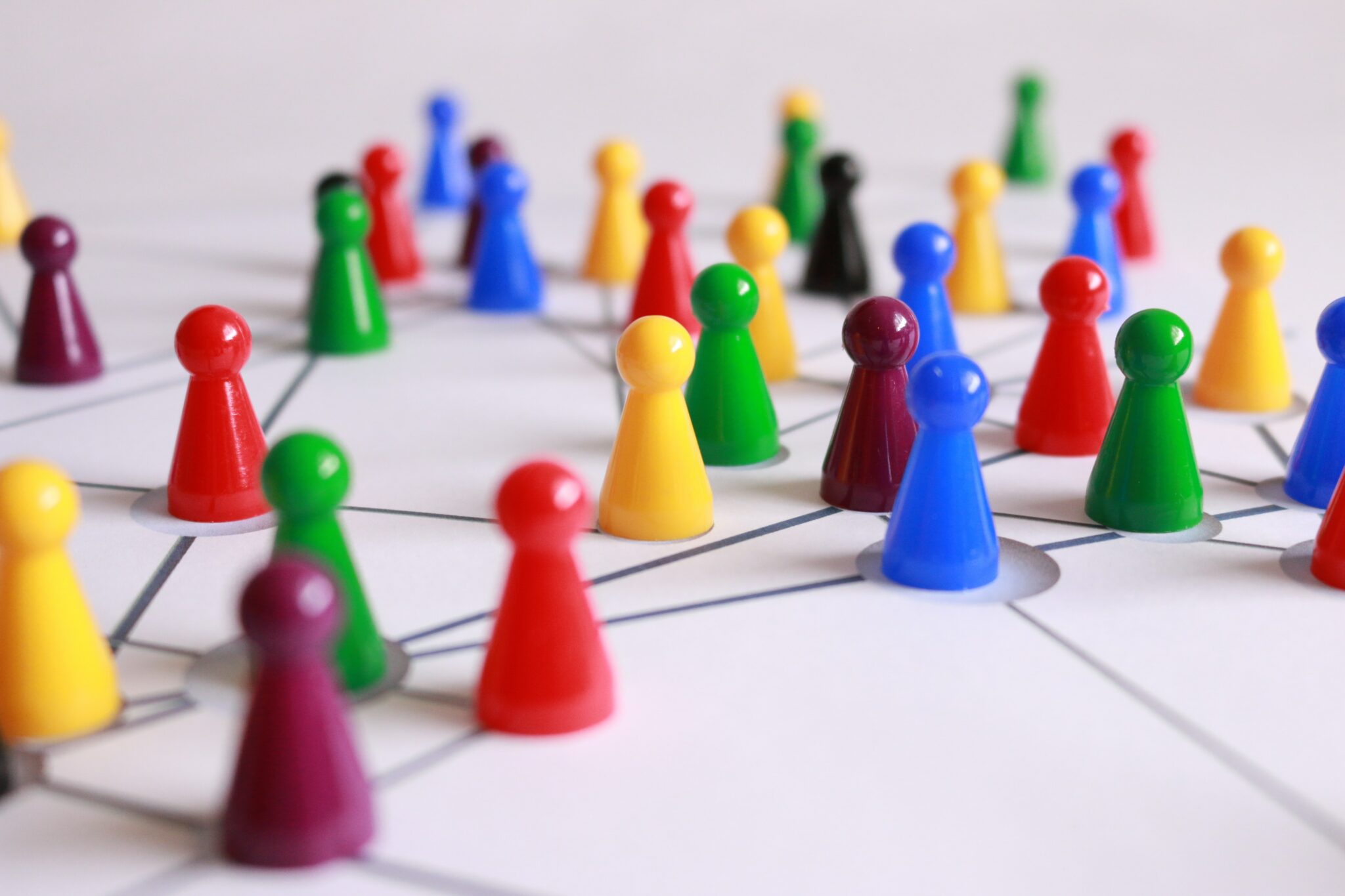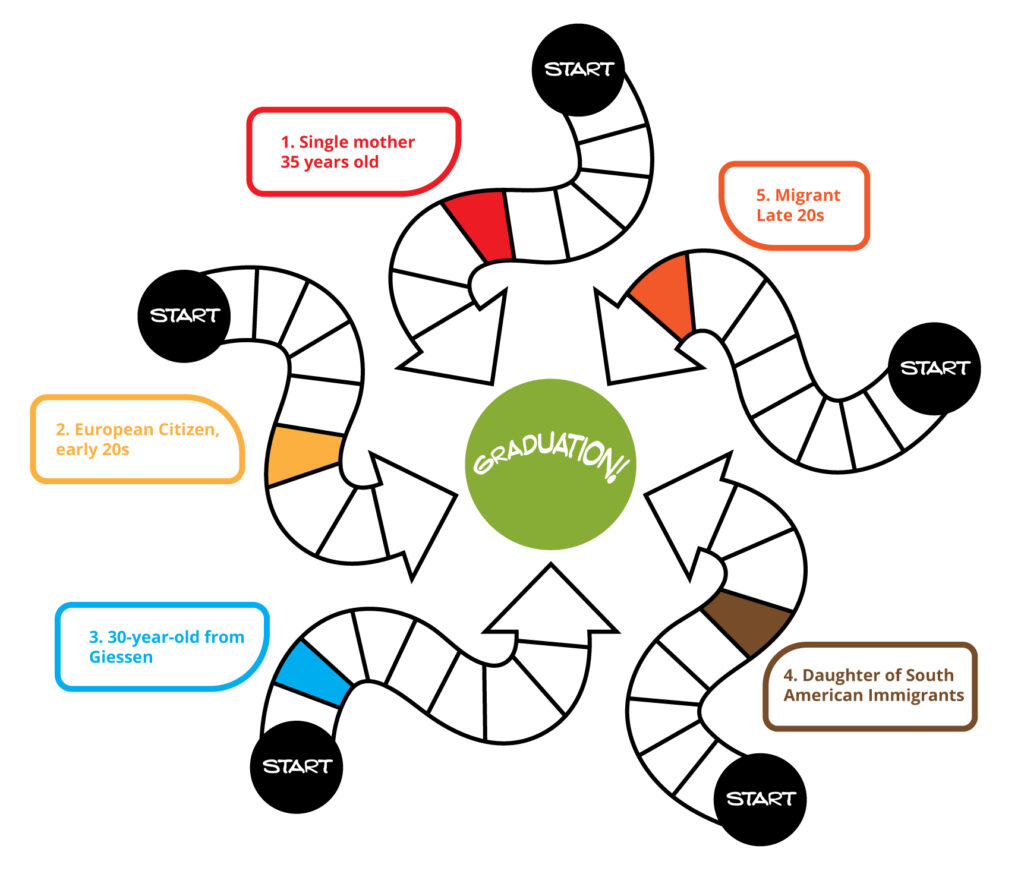
Brief description
The following exercise is a board game that aims at making visible challenges and difficulties of everyday life – academic-related and otherwise – connected to Neoliberal Compliance, Eurocentrism, and Migra*BPoC Resistance, as well as enforcing strategies of mutual cooperation and support.
The activity’s methodology is inspired by Paulo Freire’s ideas on exercises of codification and de-codification, which entails a three phase activity.
Firstly, a common issue within the participants is identified in a quasi-ethnographic approach; i.e., through carefully listening to the group, educators/ researchers identify topics that afflict the participants. Following, these topics are codified in one observable support – a board game in this case – in order to present and represent the issue in an observable manner. Lastly, the situations observed during the game should be discussed with the participants under an organized moderation (the de-codification), connecting the circumstances observed during the game with the participants’ everyday life.

Game Structure
The Academic Carousel is a board game that accompanies 5 players on their way to graduation at the university. The students know each other since they are all attending the same semester of the same degree program. The aim is to reveal the challenges of everyday university life arising for Migra*BPoC students.
The exercise will take about 60 to 90 minutes and ends when all players reach the center of the game, which is ultimately the aim of the game. Further the game ends if the players run out of Event Cards or time.
The exercise consists of 4 phases:
- Each player is getting introduced to Miro to enter the game, where they also receive an individual Character Card. The introduction and allocation of the Character Card should be done at least one day before the actual game starts (in written form or by meeting in person on Zoom). The participants should have enough time to prepare their roles by using the pre-established characteristics and the document ”Questions on role finding” to make up a personage, filling with content and imagining a personal background and biography, a history, socio-economic situation and so forth. The participants are asked to write down some weaknesses and strengths on the provided space on Miro, those will help them later to master the Event Cards. The creation of the role of the Character Card can be done individually or in groups. In this case all participants with the same Character Card come together and build up their role collectively.
- On the actual day of the game, all participants meet in the plenary on Zoom to receive a detailed introduction (including the Guidelines) to the game by the teacher or initiator of the game. Depending on the number of participants, they will be divided into three to six groups. There should be at least two players and one moderator to play the game.
Each group is playing the game on Miro on a given, individual board.
At first, the players are asked to present their prepared characters to the other players of the group (10 minutes). - Now the game can start. The players choose a game piece (a star) and place it next to the short description of their character at the beginning of the path.
The moderator is in charge to guide the game and reads out loud the Event Cards, pays attention to the time management, ensures respectful communication and makes notes on the respective moves.
After the moderator reads out loud the first of the four Event Cards, the group should discuss together to whom this event might present a problem (and why) and decide who of them can go forward (either on their own or through support of others) and who cannot.
The game ends when the whole team reaches the center and graduates; if they run out of Event Cards or time (after 50 minutes).
The participants are asked to take a screenshot at the end of the game to compare the game results with the other groups.
Every draw of an Event Card is a participative moment, where the players must debate together whether they can go forward or not, and point out the reasons. Each Event Card provides questions to help reflect on the decisions. This is also a moment to find solutions and help each other to walk ahead; as the target of the exercise is that everybody reaches the last point. The picking of Event Cards continues until all players reach the center of the board or until they run out of Event Cards.
Eventually, the exercise can end with no one reaching the center, and/ or they can go further and leave someone behind in one round, if they cannot identify options for mutual support to a specific Event Card.
- Finally, each participant is reflecting individually on the role during the game by using the “Reflection Question” (10 minutes).
After that, all groups will meet in the plenary on Zoom again to have an end discussion/ reflection on the game, led by the teacher or initiator (10 minutes).
In this phase, the participants can exchange their experiences, feelings, and thoughts they had during the game and analyze and reflect on them. The empowering concept of the game is located in understanding reality as a socio-historically constructed, and as such can be changed. As every person is a constituent part of society, even under oppressive bureaucratic systems people can rebel against it and make changes. Therefore, one source of power is to understand that life is changeable. That means to perceive that a discriminated person, who usually feels small in relation to Eurocentric norms and neoliberal challenges, can be able to resist these adversities building bridges, as the barriers are not as organic and unavoidable as they seem to be.
Objectives
Altogether, the exercise contributes to the following reflections:
The exercise aims to create awareness on structural and institutional discrimination, unequal distribution of opportunities in society and opportunities for participation. The participants should identify and reflect circumstances in which Migra*BPoC students accept or comply with norms that hinder their full academic life experience to either avoid further problems or to focus on difficulties perceived as more urgent.
It unveils personal daily and/ or institutionally organized acts when Migra*BPoC students gather energy to cope with their challenges and resist.
Sensitisation and reflection of the prevailing and one’s own stereotypes about different groups as well as of one’s own intersectional privileges and the reasons they are connected to (e.g. group membership, and being perceived to belong to a certain group) and what consequences this has for everyday life and studies is another objective.
Necessary Materials
Required reading (concepts/tools)
Expected Results
- To create awareness on structural and institutional discrimination, unequal distribution of opportunities in society and opportunities for participation.
- To underline and discuss patterns and norms that are perceived as natural and logical, but are socio-historical constructs based on white privilege and Western European colonialism.
- To identify and reflect circumstances in which Migra*BPoC students accept or comply with norms that hinder their full academic life experience to either avoid further problems or to focus on difficulties perceived as more urgent.
- To unveil personal daily and/ or institutionally organized acts when Migra*BPoC students gather energy to cope with their challenges and resist.
- Sensitisation and reflection of the prevailing and one’s own stereotypes about different groups as well as of one’s own intersectional privileges and the reasons they are connected to (e.g. group membership, and being perceived to belong to a certain group) and what consequences this has for everyday life and studies is another objective.
- The try to promote and impulse for discussion about the distribution of opportunities and (structural) discrimination, for mutual support and cooperation, in order to understand, create and strengthen interpersonal support networks and alliances.
- To promote contact between people with similar issues, enabling the awareness that the barriers are not an individual incapacity.


